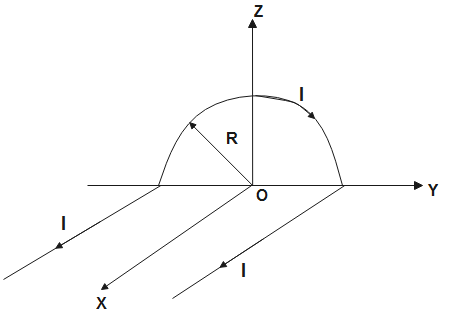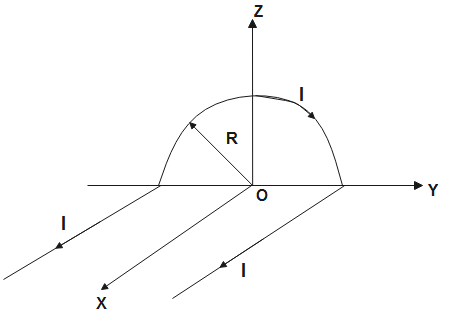Question
Question: A wire carrying current \(I\) has the shape as shown in the adjoining figure. Linear parts of the wi...
A wire carrying current I has the shape as shown in the adjoining figure. Linear parts of the wire are very long and parallel to the x-axis while the semicircular portion of radius R is lying in the Y-Z axis. Magnetic field at point O is-
(A). B=−4πRμ0I(μi^×2k^)
(B). B=−4πRμ0I(πi^+2k^)
(C). B=4πRμ0I(πi^−2k^)
(D). B=4πRμ0I(πi^+2k^)

Solution
Magnetic field at point O in space is the resultant of different magnetic fields due to current carrying elements. The magnetic field due to a current carrying element depends on the length, current, distance between the point and element and the angle between the line joining the element and point and the element.
Formula Used:
B=4Rμ0I
B=4πRμ0I
Complete step-by-step solution:
The magnetic field due to different current carrying elements is different which can be derived using Biot Savart’s law of ampere circuit law.
According to the Biot Savart’s law,
When a conductor has current flowing through it, the magnetic field around it is-
B∝r2Idlsinθ
Here,
I is the current flowing through the conductor
dl is the length of the current carrying element
θ is the angle between the line joining the point and element and the element
r is the distance between the point and element

In space, there are three elements carrying current. The resultant magnetic field vector acting on point O is the sum of all the magnetic field vectors due to different elements in space.
The magnetic field due to a semicircular wire is given by-
B=4Rμ0I
Here, B is the magnetic field
I is the current flowing through the wire
R is the radius of the wire
The right hand thumb rule tells us the direction of the magnetic field
The magnetic field due to due to a long straight current carrying wire at one end is given by-
B=4πRμ0I
Here, R is the distance of the point from the element
The magnetic field at point O due to the different elements is-
B=B1+B2+B3⇒B=4Rμ0I(−i^)+4πRμ0I(k^)+4πRμ0I(k^)⇒B=4πRμ0I(−πi^+2k^)∴B=4πRμ0I(πi^−2k^)
The resultant magnetic field vector acting on point O is 4πRμ0I(πi^−2k^).
Therefore, the correct option is (C).
Note:
Magnetic field at the axis of a long current carrying wire is zero. According to the right hand thumb rule; for a semicircular wire, if current is denoted by the fingers, direction of field is given by the thumb. For a straight wire, if the thumb is in the direction of current, then fingers represent the direction of the field.
